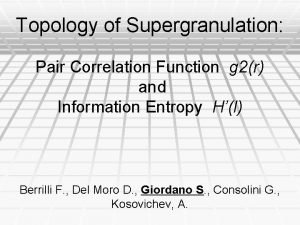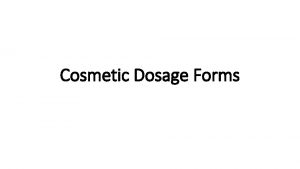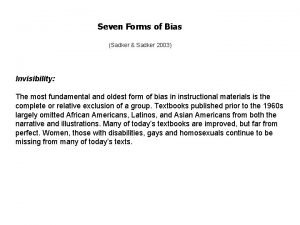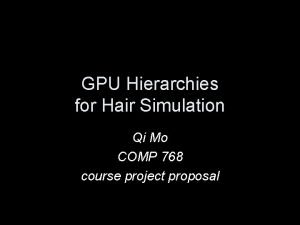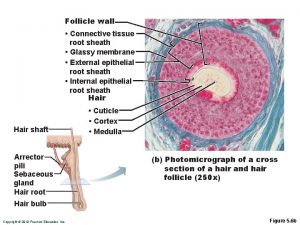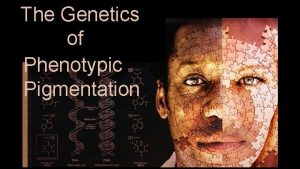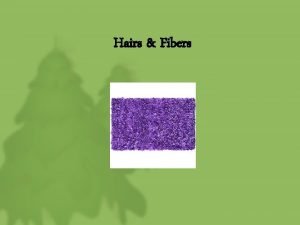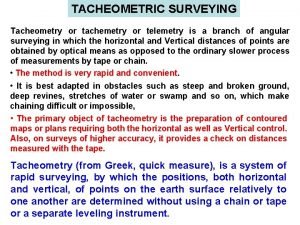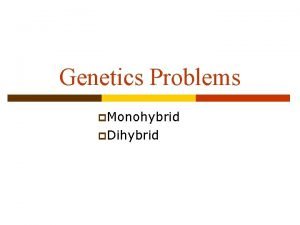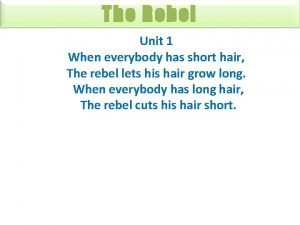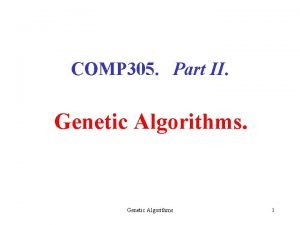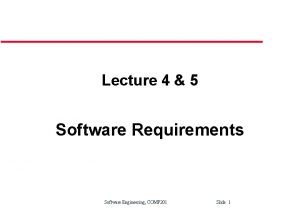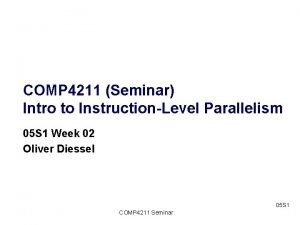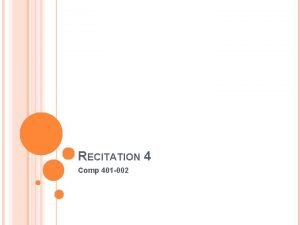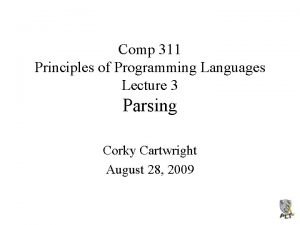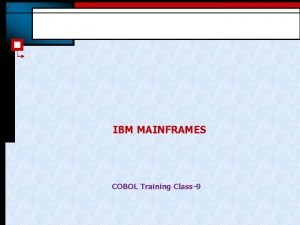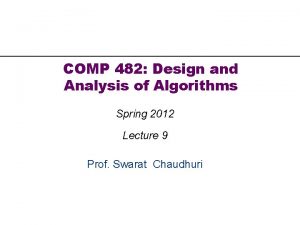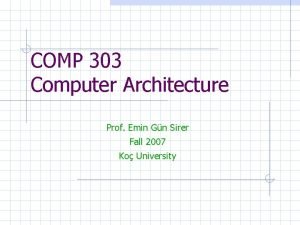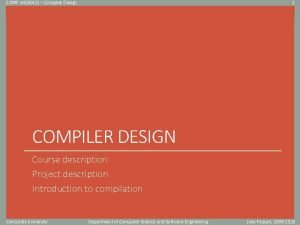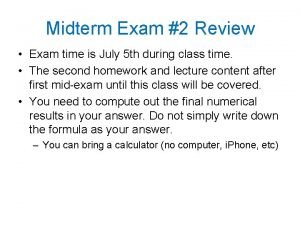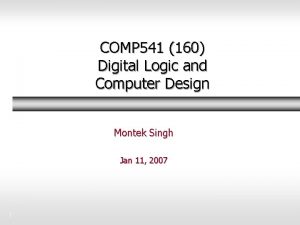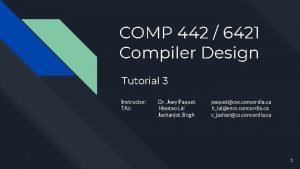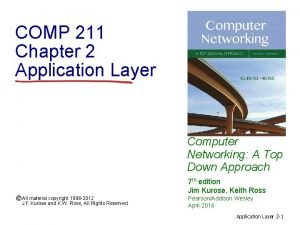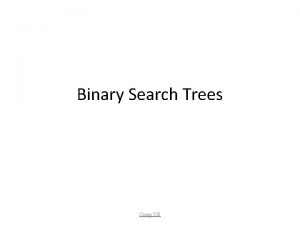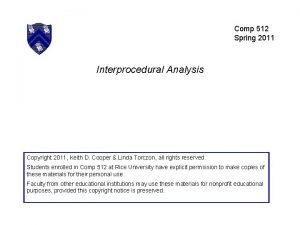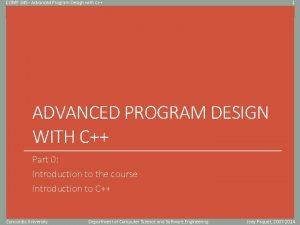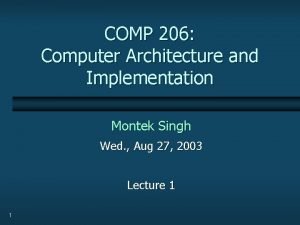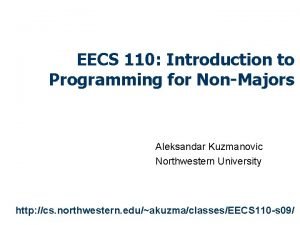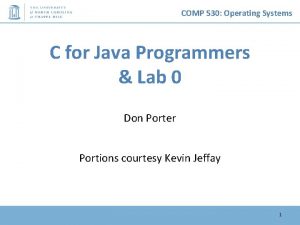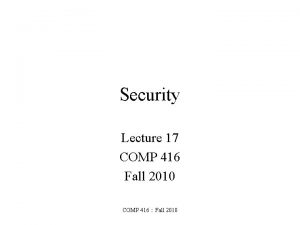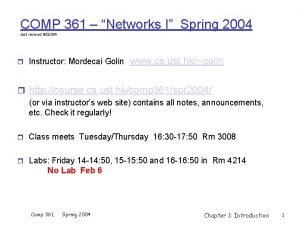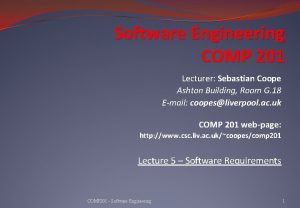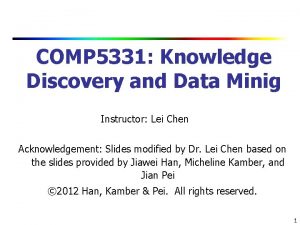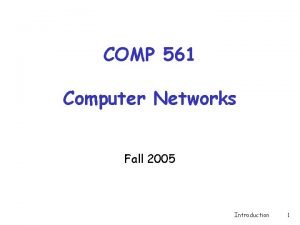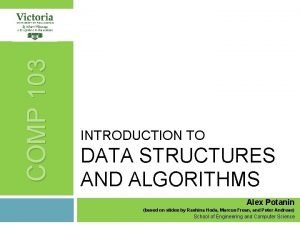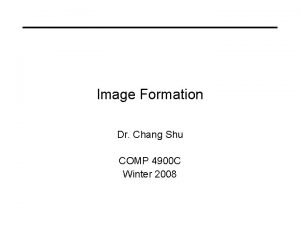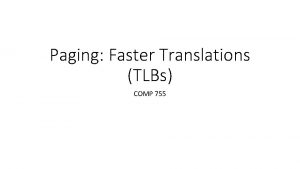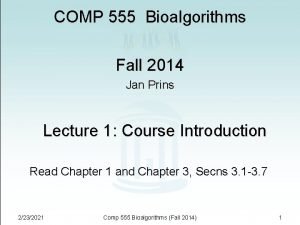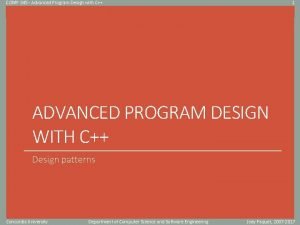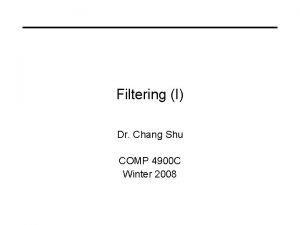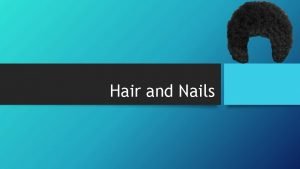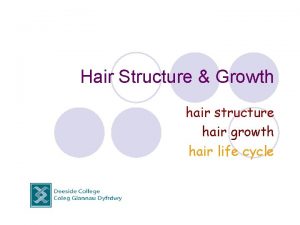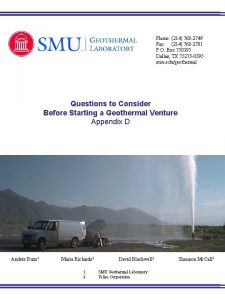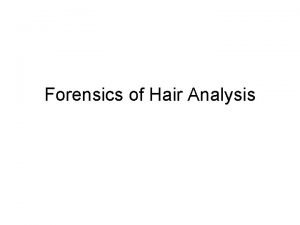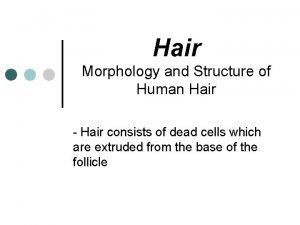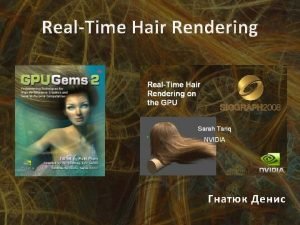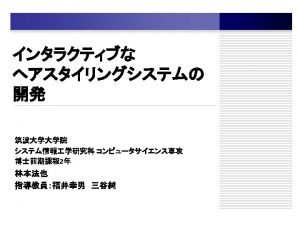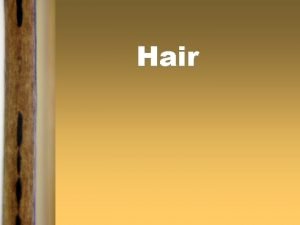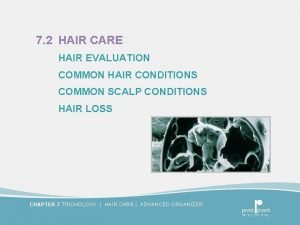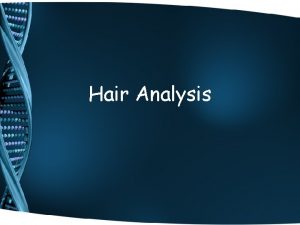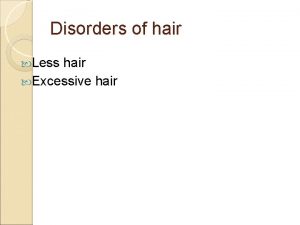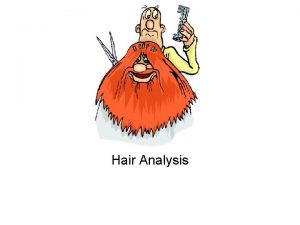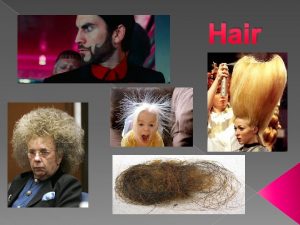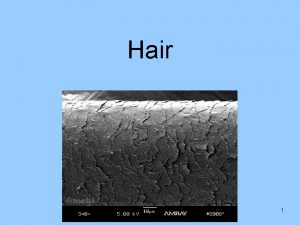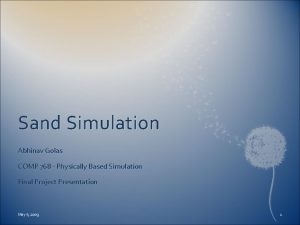Hair Simulation COMP 768 Qi Mo Motivation Cosmetic

































































- Slides: 65

Hair Simulation COMP 768 Qi Mo

Motivation • Cosmetic prototyping • Entertainment industry - Feature animation - Interactive systems

Motivation • Cosmetic prototyping • Entertainment industry - Feature animation - Interactive systems

Motivation • Cosmetic prototyping • Entertainment industry - Feature animation - Interactive systems

Motivation • Cosmetic prototyping • Entertainment industry - Feature animation - Interactive systems

Motivation • Cosmetic prototyping • Entertainment industry - Feature animation - Interactive systems

Motivation • Cosmetic prototyping • Entertainment industry - Feature animation - Interactive systems

Motivation • Cosmetic prototyping • Entertainment industry - Feature animation - Interactive systems

Challenges • Over 100, 000 hair strands • Real hair properties still under research

Overview • Styling Geometry of hair Density, distribution, orientation of hair strands • Simulation Dynamic motion of hair Collision between hair and other objects Mutual hair interactions • Rendering Light scattering and shadows

Overview • Styling Geometry of hair Density, distribution, orientation of hair strands • Simulation Dynamic motion of hair Collision between hair and other objects Mutual hair interactions • Rendering Light scattering and shadows

Hair Geometry • Curliness: Straight, wavy, curly, etc. • Shape of cross-section - Asian hair strand: circular - African hair strand: very elliptical - Caucasian hair strand: between the two

Hair styling • Attaching hair to the scalp • Global hair shape • Fine details

Attaching hair to the scalp • 2 D Placement • 3 D Placement • Distribution of hair strands on the scalp

Global Hair Shape Generation • Geometry-based hairstyling - Parametric surface - Wisps and generalized cylinders • Physically-based hairstyling - Fluid flow - Styling vector and motion fields • Generation of hairstyles from images

Global Hair Shape Generation • Geometry-based hairstyling - Parametric surface - Wisps and generalized cylinders

Global Hair Shape Generation • Geometry-based hairstyling - Parametric surface - Wisps and generalized cylinders

Global Hair Shape Generation • Geometry-based hairstyling - Parametric surface - Wisps and generalized cylinders

Global Hair Shape Generation • Physically-based hairstyling - Fluid flow - Styling vector and motion fields

Global Hair Shape Generation • Physically-based hairstyling - Fluid flow - Styling vector and motion fields

Global Hair Shape Generation • Physically-based hairstyling - Fluid flow - Styling vector and motion fields

Global Hair Shape Generation • Geometry-based hairstyling - Parametric surface - Wisps and generalized cylinders • Physically-based hairstyling - Fluid flow - Styling vector and motion fields • Generation of hairstyles from images

Finer Details

Finer Details

Finer Details

Hair Mechanics • • Difficult to shear and stretch Easy to bend and twist Anisotropic friction Hair geometry also affects motion

Dynamics of Individual Strand • • Mass-spring systems One dimensional projective equations Rigid multi-body serial chain Dynamic super-helices

Mass-Spring Systems • Particles connected by stiff springs bending rigidity ensured by angular spring at each joint ü Simple and easy to implement But does not account for tortional rigidity or non-stretching of each strand

One-dimensional Projective Equations • Hair strand as a chain of rigid sticks ü Easy to implement ü Efficient ü Non-stretching ü Bending No tortional stiffness Difficult to handle external punctual forces

Rigid Multi-body Serial Chain • Hair strand as a rigid multi-body open chain • Bending and twisting DOFs only, stretching DOF removed • Motion computed using forward dynamics

Super-Helices • Accurate Mechanical Model Kirchhoff Equation and Cosserat Curves

Super-Helices Model for Strands • Cosserat curve: a one-dimensional rod • A material frame defined at each point on the centerline

Kinematics r (s, t) – centerline s – curvilinear abscissa along r t – time ni(s, t) – axis of material frame

Kinematics Ω(s, t) – Darboux Vector τ(s, t) – twist κi (s, t) - curvatures

Spatial Discretization N– number of segments Q– index of segments 1≤Q ≤ N – constant curvatures & twist χQ (s) – characteristic function of Q qi, Q(t)

Dynamic Equations • Solve equations of motion using Lagrangian mechanics q (t) – generalized coordinates T (q, , t) – kinetic energy U (q, t) – internal energy D (q, , t) – dissipation potential F (s, t) – linenic density of forces Ji. Q (s, q, t) – Jacobian matrix

Energy Terms – mass per unit length (EI)0 – torsional stiffness (EI)1, 2 – bending stiffness κ 0 – natural twist κ 1, 2 – natural curvatures γ – internal friction coefficient ρS

Equation of Motion • Symbolic Integrations – inertia matrix – stiffness matrix qn – rest position A – all remaining terms

Key Features • Discrete model for Kirchhoff equations • Space integrations performed symbolically • Stiff constraint of inextensibility incorporated into reconstruction process, therefore removed from the equations of motion • Stable simulation even for small N • When N →∞, Kirchhoff Eq recovered

Parameters of Model • Chosen based on physical measurements - Hair mass - Mean radius and ellipticity - Natural curliness: - Internal friction γ

Results and Validation

Dynamics of a Full Hairstyle • Hair as a Continuous Medium • Hair as Disjoint Groups • Collision detection and response • Hair-hair and hair-object interaction

Hair as a Continuous Medium • • Fluid Dynamics Loosely Connected Particles Interpolation between Guide Hair Strands Free Form Deformation

Animating Hair with Fluid Dynamics • Kinematically link each hair strand to fluid particles in their vicinity • Hair-hair interactions modeled by pressure and viscosity forces between strands • Hair-body interactions modeled by creating boundary particles around solid objects ü Captures the complex interactions of hair strands Cannot capture the dynamic clustering effects Computationally expensive

Loosely Connected Particles • Use a set of fluid particles that interact in an adaptive way • Neighboring particles with similar orientations are linked • During motion particles interact with other particles in its local neighborhood through breakable links • Allows separation and grouping while maintaining constant hair length

Interpolation between Guide Hair Strands • Only simulate a sparse set of hair strands • Remaining strands created by interpolation • Only use the guide strands to detect and handle collisions - Might miss collisions

Free Form Deformation (FFD) • Define a mechanical model for a lattice surrounding the head • Lattice deformed using a global volumetric FFD scheme • Good for simulating complex hairstyles when head motion has low magnitude • Cannot reproduce discontinuities in hair

Hair as Disjoint Groups • Group nearby hair strands, simulate groups as independent, interacting entities ü Account for discontinuities during fast motion ü Save computation time • Simulation of - Hair strips - Wisps

Simulation of Hair Strips • Model groups of strands using a thin flat patch, e. g. a NURBS surface ü Achieves real time using a strip to represent tens or hundreds of hairs Limited in the types of hairstyle and motion

Simulation of Wisps • Group neighboring strands into wisps • Wisp representations - Trigonal prism-based wisp - Typical strandom displacements - Layered wisp model

Multi-resolution Methods • Tradeoff: performance and realism • Level-of-detail representations • Adaptive clustering

Level-of-Detail Representations • Three discrete levels of detail - strands, clusters, and strips • Common representation by subdivided curves and surfaces • Collision detection using Swept Sphere Volumes • Dynamic level transition based on visibility, viewing distance, and motion

Adaptive Clustering • Continuously adjustment with Adaptive Wisp Tree (AWT) • Dynamically splits or groups wisps while preserving tree-like structure • Implicitly models hair interactions

Hair Rendering • • Representation Light scattering in hair Hair self-shadowing Acceleration

Representation • Explicit representation curved cylinder, trigonal prism, triangle strips thin -> undersampling -> blending techniques • Implicit representation volumetric textures, cluster model with density avoid aliasing, but traversal may be expensive

Hair Optical Properties • Hair composed of amorphous proteins as a transparent medium with an index of refraction η= 1. 55 • Contain pigments that absorb light in a wavelength-dependent way -> color • Circular/elliptical fibers treated as onedimensional

Light scattering • One-dimensional reformulation of BRDF • Reflection and refraction in cylinders • Physical measurement of scattering

Light Scattering Model • Kay and Kajiya’s model • Marschner’s model

Self-shadowing • Challenges - complex geometry - strong forward scattering properties • Ray-casting through a volumetric representation • Shadow maps

Rendering Acceleration • Approximating Hair Geometry • Interactive Volumetric Rendering • Graphics Hardware

Summary • Styling Hair geometry Attaching hair to scalp, generate global shape, capture finer details • Simulation Hair mechanics Mass-spring systems, One dimensional projective equations, Rigid multi-body serial chain, Dynamic super-helices Continuous medium, disjoint groups Multi-resolution methods • Rendering Hair optics Representation, light scattering, self-shadowing, acceleration techniques

Open Challenges • Physically-based realism • Visual realism with high user control • Computations acceleration

Reference 1. 2. 3. 4. 5. Anjyo, Usami & Kurihara (1992): A simple method for extracting the natural beauty of hair Bertails, Kim, Cani & Neumann (2003): Adaptive wisp tree – a multiresolution control structure for simulating dynamic clustering in hair motion Chang, Jin & Yu (2002): A practical model for hair mutual interactions Hadap & Magnenat-Thalmann (2001): Modeling dynamic hair as a continuum Koh & Huang (2000): Real-time animation of human hair modeled in strips

6. Kurihara, Anjyo & Thalmann (1993): Hair animation with collision detection 7. L'Oréal (2005): Hair Science www. hair-science. com 8. Magnenat-Thalmann & Hadap (2000): State of the art in hair simulation 9. Petrovic, Henne & Anderson (2007): Volumetric methods for simulation and rendering of hair 10. Plante, Cani & Poulin (2001): A layered wisp model for simulating interactions inside long hair 11. Rosenblum, Carlson & Tripp (1991): Simulating the structure and dynamics of human hair: Modeling, rendering, and animation

12. Volino & Magnenat-Thalmann (1999): Animating complex hairstyles in real-time 13. Watanbe & Suenaga (1992): A trigonal prism-based method for hair image generation 14. Ward, Bertails, Kim, Marschner, Cani & Lin (2007): A survey on hair modeling: styling, simulation and rendering 15. Ward & Lin (2003): Adaptive grouping and subdivision for simulating hair dynamics 16. Ward, Lin, Lee, Fisher & Macri (2003): Modeling hair using level-of-detail representations
 Nn video
Nn video Mdi-768
Mdi-768 768-1007-1-nd
768-1007-1-nd Fda cosmetic labeling guide
Fda cosmetic labeling guide Cosmetic psychopharmacology
Cosmetic psychopharmacology Behavioure
Behavioure List of acts in pharmaceutical jurisprudence
List of acts in pharmaceutical jurisprudence Bpfk cosmetic guideline
Bpfk cosmetic guideline Cosmetic psychopharmacology
Cosmetic psychopharmacology Cosmetic pif template
Cosmetic pif template Milada cosmetic surgery hospital
Milada cosmetic surgery hospital Simplest dosage form
Simplest dosage form Eu cosmetic product notification portal (cpnp)
Eu cosmetic product notification portal (cpnp) Invisibility bias in textbooks examples
Invisibility bias in textbooks examples Rucodem
Rucodem Simulation of hair appearance and motion download
Simulation of hair appearance and motion download Hair follicle labeled
Hair follicle labeled Hair grows in diagonal tubes called hair
Hair grows in diagonal tubes called hair The two primary parts of hair are the hair fiber and the
The two primary parts of hair are the hair fiber and the Dark hair and blonde hair parents
Dark hair and blonde hair parents Medulla pearl shape
Medulla pearl shape Uses of tacheometric surveying
Uses of tacheometric surveying Hh
Hh The rebel keep silent when everybody
The rebel keep silent when everybody Dairy comp 305 tutorial
Dairy comp 305 tutorial Comp requirements
Comp requirements Comp 4211
Comp 4211 Comp 401
Comp 401 Comp 311 textbook notes
Comp 311 textbook notes Hotel comp set benchmarking
Hotel comp set benchmarking Aashto comp
Aashto comp Usage clause in cobol
Usage clause in cobol Comp 482
Comp 482 Comp 482
Comp 482 Comp 303
Comp 303 Comp 442
Comp 442 Comp 248 midterm
Comp 248 midterm Comp4462
Comp4462 Comp 541
Comp 541 Comp 442
Comp 442 Comp 211
Comp 211 Ubi comp
Ubi comp Comp550
Comp550 Comp 512
Comp 512 Uab oncology faculty
Uab oncology faculty Comp345
Comp345 Aldo moro sutri
Aldo moro sutri Comp 3220
Comp 3220 Comp 206
Comp 206 Cs110 northwestern
Cs110 northwestern Comp3500
Comp3500 Comp 530
Comp 530 Comp416
Comp416 Comp 361
Comp 361 Ap computer science a recursion
Ap computer science a recursion Comp 201
Comp 201 Comp 201
Comp 201 Comp 5331
Comp 5331 Comp 561
Comp 561 Comp103 ecs
Comp103 ecs Comp 206
Comp 206 Digitization
Digitization Comp 755
Comp 755 Comp 555 unc
Comp 555 unc Comp 345
Comp 345 Comp4900
Comp4900

